Cape Ann Granite (1928), a cornerstone of the Fondation Beyeler’s case for Edward Hopper as a landscape painter, might seem a world away from his indelible images of ennui in the nocturnal city. As curator Ulf Küster remarks in the exhibition catalogue, this enduringly popular artist remains ‘one of the great known unknowns’ – a startling claim, perhaps, yet one that this focused but conscientious exhibition justifies. Cape Ann Granite looks severe, not immediately ingratiating, but it snags you with its ground-away molar forms. There is an implicit connection to the metropolis, too. Granite from Cape Ann in Massachusetts was extensively quarried for paving and building: even this apparent wilderness was marked, in Hopper’s eyes, by the doleful presence of human activity in landscape. This industry had faltered in the 1920s, though, with the adoption of asphalt and concrete. Hacked, then abandoned; this goes some way to accounting for the peculiar intensity of the granite – which in its mute presence has a Mary Celeste quality. The other part of the equation, of course, is Hopper, whose exacting attention is meted out with a softly abbreviated touch. Granite protrusions and windswept turf interlock in arrested poise, with clawlike shadows that reach towards fingers of stratus clouds, as if they might join hands. Dunescapes tend towards an anthropomorphic sensuality – as suits Hopper, this is withheld, but detectable. The nightmarish Central Park-set allegory Bridle Path (1939), also exhibited, continues Hopper’s Courbet-inflected exploration of crevices to an arch extreme.
Hopper’s technique never telegraphs its skilfulness; his paintings seduce the viewer by slowly turning an invisible dial of intensity. The early pictures from his salad days in Paris – Le Bistro or The Wine Shop and Valley of the Seine (both 1909) – are, with hints of Whistler and Corot, more suavely painted than works in his fully realised idiom. Revealing, too, are charcoal studies suggesting how adept a commercial illustrator he was; they intrigue because they are the rakish, no-nonsense sketches of a painter searching for promising material, and their brisk, animated lines seem to be subsumed in the painstaking making of paintings. Lighthouse Hill (1927), for instance, takes up Hopper’s unerring chiaroscuro, which proves as decisive on the coast as it is in New York. Tufted undulations of dune recede into a luxuriant shadow with a calibrated internal rhythm. I lingered on the counterbalancing of the starkly lit pawn of a lighthouse by the lone wisp of gently angled horsehair cloud. Railroad Sunset (1929) softens enigmatic geometry with tender atmosphere: hard edges, like the signal box roof, are slightly worn. Largely uninterrupted horizontals, seen also in Road and Trees (1962), gently quaver. The languid sine wave of the bottle-green hillside has a quiet certainty; railroad tracks faintly gleam in the dusk: banding that anticipates what Peter Doig has called ‘strip[s] of existence’. Hopper wanted, as he wrote of another painting in 1939, ‘to give a sensation of great lateral extent […] to make one conscious of the spaces and elements beyond the limits of the scene itself’. That figures; but it’s just a fundamental condition that his pictures hold, as Walter Wells has written, ‘no possibility of denouement’.
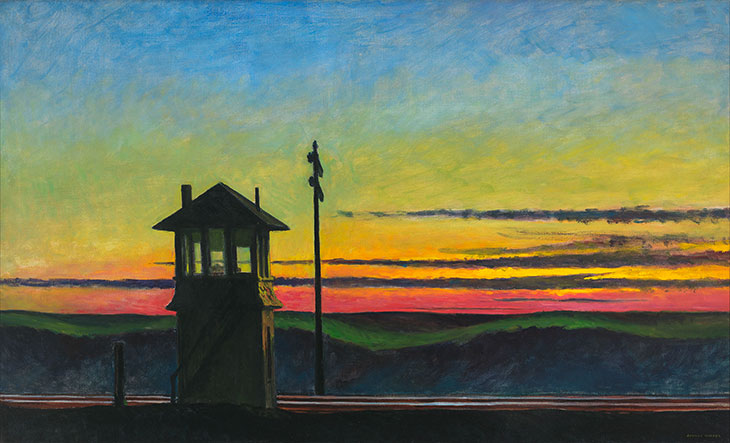
Railroad Sunset (1929), Edward Hopper. Digital image Whitney Museum of American Art/licensed by Scala, Florence; © 2019/© Heirs of Josephine N. Hopper/Licensed by Artists Rights Society (ARS), New York
In a lecture in 2013, the critic Brian O’Doherty drew attention to the nuances of Hopper’s window dressing: how closed blinds are, how tightly curtains drawn, seems to count. Slender, gloomy apertures between curtains might provide the elongated pupils of surrogate eyes in paintings – portraits? – of houses such as Cape Cod Sunset (1934), High Noon (1949) and Two Puritans (1945). But they also offer the blank gaze of abstraction. David Anfam has described the formative influence of Hopper’s Chop Suey (1929) on Rothko, and though Hopper might have winced at dwelling on abstract compartments in his work, he shares with Rothko a supreme tonal exactitude. In reshuffled bars of acid yellow blinds, mauve-grey curtains, and soft blue shadows, his visual solutions are clearly touched by the same modernity, even for spooky purposes. The dry grass surrounding the house in High Noon, a distinctive wheat-blond, looks soft as carpet fluff. There’s no scrabbly path to the doorway, where a woman stands in a gown that splits like curtains. When did she last cross its threshold?
An upbringing in Nyack, a Hudson River boat-building town, must have left Hopper with a special feeling for the contours of sailing vessels. Lee Shore (1941) and The Martha McKeen of Wellfleet (1944) look shrill in reproduction, but the real things are astonishing. The boats surge and swoon, delicately tempered by hazy blond accents that twinkle off closely controlled aquamarines. The Martha McKeen’s hull is astonishing, shadows vanishing or intensifying with a consummate just-so-ness. Seagulls, comically facing the same direction, have alighted on a spit that resembles a surfacing submarine. The Bootleggers (1924/25) is a Munchian episode at dusk, its pale lemon and china-blue house looming ominously. Stairway (1949), a reimagining of his Nyack home, concerns a threshold to an inscrutable outdoors. An anomalous spearmint sky is the only instance here of the ‘noxious, pallid green’ that the writer Olivia Laing has identified as the essence of Hopper’s ‘lonely city’.
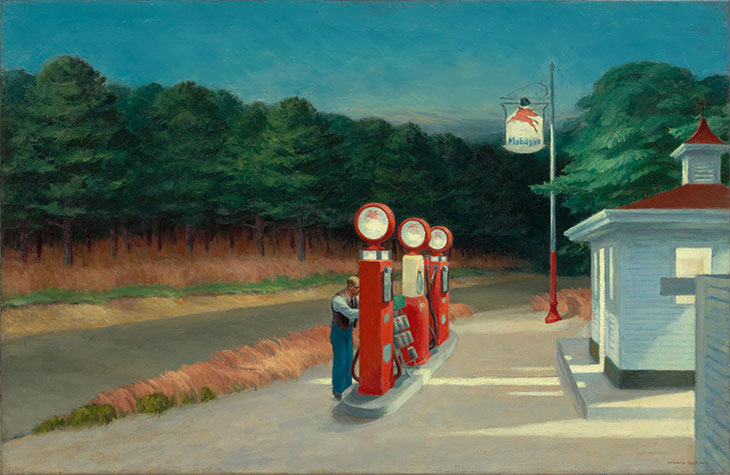
Gas (1940), Edward Hopper. Digital image Museum of Modern Art, New York/licensed by Scala, Florence; © 2019/© Heirs of Josephine N. Hopper/Licensed by Artists Rights Society (ARS), New York
The commingling of fading daylight and quietly scorching electric light is the discreet tension of Gas (1940), which rounds out the show. The Mobilgas red Pegasus logo keens towards the light of the main signpost, and repeats and recedes in the pucklike signs topping three pumps on the forecourt island. Pathos is gleaned by isolating the sprightly images of the Pegasus, and occluding them with knife-scrapings of buttery, reflected light. The logos might be embedded in cough drops. The proprietor appears locked in position. Petrol stations are a sort of limbo – nobody’s coming, or so it seems. Except they do in Wim Wenders’ Two or Three Things I Know About Edward Hopper (2020), a 3D film made for this occasion. When film-makers make painted images move, there can be a sense of impropriety, of bubble-bursting. The risk of naffness must have been severe, but Wenders’ eye for desolate landscapes and his fluency in Hopperese shine through. The fleeting look the pump attendant from Gas steals over his shoulder at Wenders’ imagined customer is ineffably true to the paintings, even while their stasis ruptures – no mean feat.
‘Edward Hopper’ is at the Fondation Beyeler, Riehen, until 26 July (exhibition dates extended).
From the April 2020 issue of Apollo. Preview and subscribe here.
Unlimited access from just $16 every 3 months
Subscribe to get unlimited and exclusive access to the top art stories, interviews and exhibition reviews.

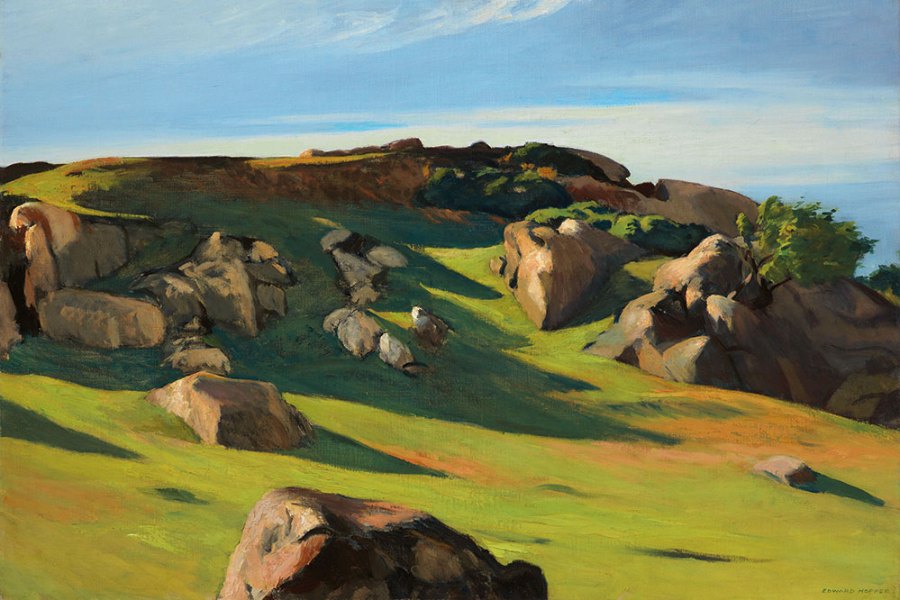
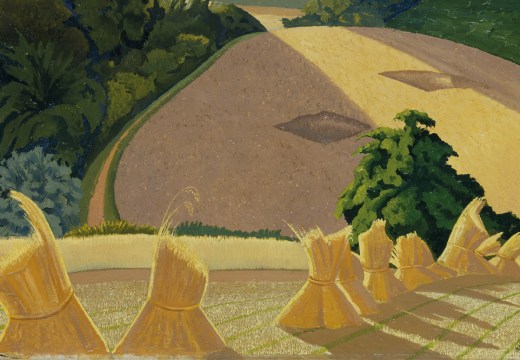
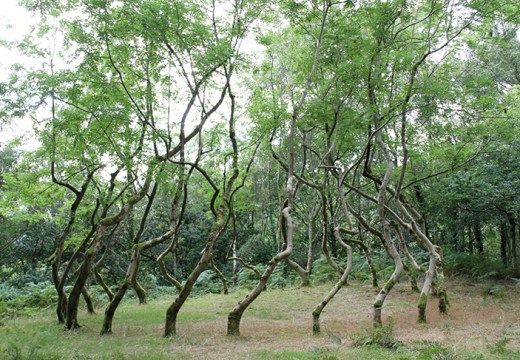
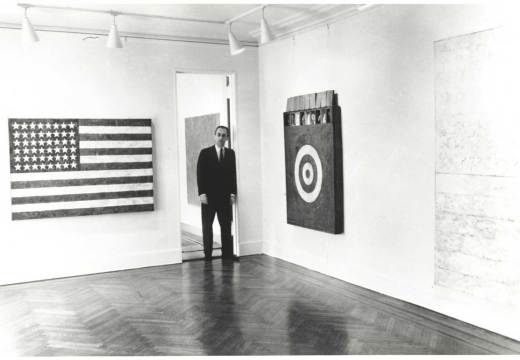









![Masterpiece [Re]discovery 2022. Photo: Ben Fisher Photography, courtesy of Masterpiece London](http://www.apollo-magazine.com/wp-content/uploads/2022/07/MPL2022_4263.jpg)
It’s time for the government of London to return to its rightful home